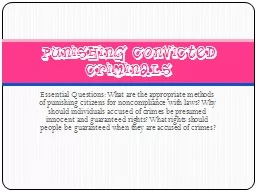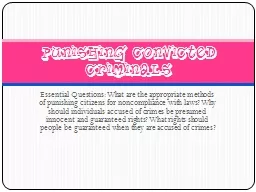PPT-Essential Questions: What are the appropriate methods of pu
Author : marina-yarberry | Published Date : 2017-08-26
Punishing Convicted Criminals Department of Corrections The Department of Corrections responsible for carrying out any sentence handed down by a court A court has
Presentation Embed Code
Download Presentation
Download Presentation The PPT/PDF document "Essential Questions: What are the approp..." is the property of its rightful owner. Permission is granted to download and print the materials on this website for personal, non-commercial use only, and to display it on your personal computer provided you do not modify the materials and that you retain all copyright notices contained in the materials. By downloading content from our website, you accept the terms of this agreement.
Essential Questions: What are the appropriate methods of pu: Transcript
Download Rules Of Document
"Essential Questions: What are the appropriate methods of pu"The content belongs to its owner. You may download and print it for personal use, without modification, and keep all copyright notices. By downloading, you agree to these terms.
Related Documents














